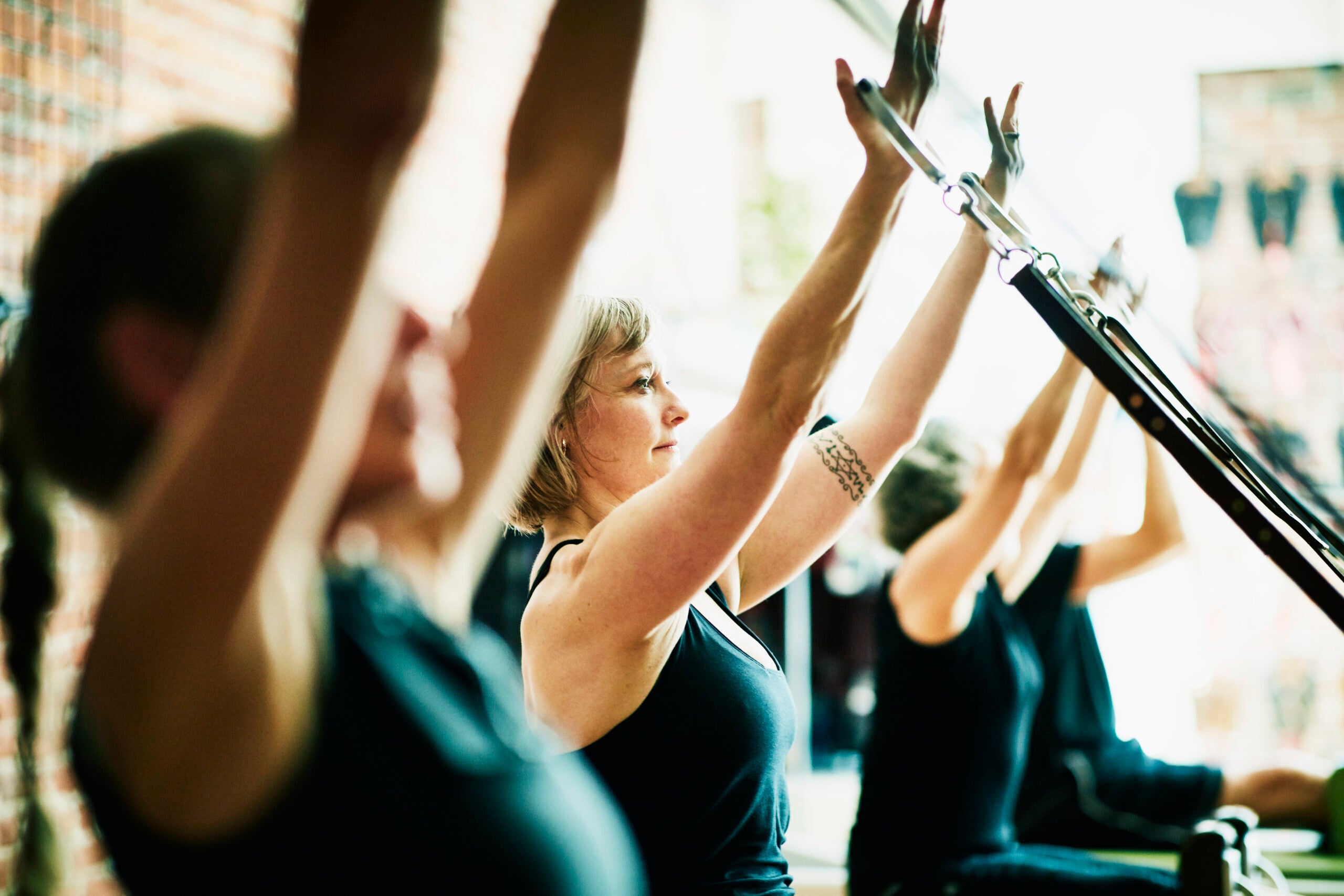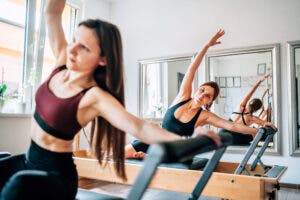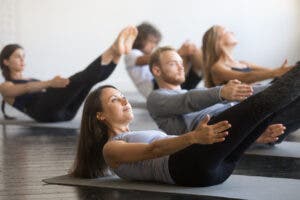Here’s How Pilates Can Make Your Yoga Practice Even Stronger

(Photo: Thomas Barwick | Getty)
I’ve moved into Half Moon Pose (Ardha Chandrasana) hundreds of times—balancing precariously with one hand on the floor, the other reaching skyward, and one leg shooting back from my hips. I thought I had it mastered. Then I enrolled in a Pilates class to assist my recovery from an injury, and when I came back to Half Moon, I discovered a whole new dimension to it.
In Pilates, I learned that I have really strong legs and had been using them to compensate for a weak midsection. Pilates not only helped me strengthen my core, it taught me how to consciously tap into the power there to create greater stability and better alignment in every yoga pose I practiced from then on. In Half Moon, I can now open my chest more fully and lengthen my spine in a way I had never experienced—and I can hold the pose much longer.
The deeper awareness of my core strength that I gained through Pilates has given me greater control over all of my movements. I discovered a center of gravity that allows me to glide in and out of yoga poses with fluidity and grace.
Pilates vs. Yoga: Similarities and Differences
Of course, I’m not alone in bringing what I’ve learned from Pilates to my yoga mat. Many yoga practitioners recognize that Pilates, a system of body conditioning designed by German-born physical trainer Joseph Pilates in the 1920s, is a rewarding complement to yoga.
Pilates is similar to yoga in more ways than one:
- Physical benefits: Yoga and Pilates are physical practices that can help increase strength and flexibility.
- Mental benefits: Both practices require mental focus and can help reduce stress.
- Poses: Many Pilates and yoga poses are similar in shape.
Interestingly, much of Joseph Pilates’s technique was derived from his study of Eastern philosophy, and many say this included yoga. In his book Pilates’ Return to Life Through Contrology, he wrote that age is gauged not by years but by the suppleness of the spine. He also noted that full, deep breathing is a key component to efficient movement.
A stint on any Pilates mat reveals similarities between Pilates exercises and yoga: Side Lift is much like Side Plank Pose (Vasisthasana), Roll Over is reminiscent of Plow Pose (Halasana), and Swimming in Pilates could be mistaken for Locust Pose (Salabhasana).
Still, the two practices are distinct. Their differences include:
- Movements: A yoga pose is held for several seconds or minutes, but in Pilates, movements are done 5 to 10 times in quick repetitions.
- Equipment: Pilates involves more equipment than yoga, such as resistance bands, foam rollers, and reformer machines.
- Variety: There are many more types of yoga than there are types of Pilates.
- Purpose: Yoga is a philosophical and spiritual system of beliefs, whereas Pilates was created to develop the physical body, specifically the core.
“There is a method to the practice, with a simultaneous emphasis on flow of movement, but a controlled flow,” explains Rebecca Slovin, a certified Pilates and yoga instructor in San Francisco.
Here’s How Pilates Can Make Your Yoga Practice Even Stronger
Pilates focuses on and develops core strength in a way that is not emphasized in most yoga classes. “Pilates helps some of my [yoga] students slow down and work deeper,” Slovin says. Ultimately, she says, it can help yoga practitioners build strength, avoid injury, and sometimes advance into poses that they hadn’t previously felt were possible.

1. Builds Your Core Strength
When you hear the word Pilates, you might think of an apparatus involving pulleys, springs, or a movable platform used for a resistance workout. While equipment is an integral part of Pilates practice, the ultimate goal is to get to the mat work—a series of 34 exercises outlined in Return to Life.
Done correctly, mat work is a lot harder than performing the hundreds of moves designed for the Universal Reformer, the Trapeze Table, the Step Barrel, and other types of Pilates equipment. Without the support of the apparatuses, students must rely solely on their own strength.
But whether practitioners work with an apparatus or on a mat, the emphasis is on using the breath to channel core energy into the center of the body and out to the limbs. The core, in Pilates, refers to the body’s center of gravity and is composed of the muscles of the lower abdomen, lower back, buttocks, and pelvic floor.
The aim in Pilates is to engage and strengthen the transversus abdominis (the deepest layer of abs that wrap around the torso horizontally), the obliques, the lower back muscles, and the pelvic floor during complex movements. By doing so, you develop a strong, corsetlike support system that protects your back from injury.
“Many dancers and yogis who come to Pilates are hyper-flexible,” says former dancer Bob Liekens, a yoga teacher and the education director of Power Pilates. And sometimes people whose bodies are extremely bendy rely so heavily on their flexibility that they just let their muscles stretch rather than engaging and strengthening them.
“If the center is not realized or strengthened, then the structure is weak and the energy is not being channeled properly,” Liekens says. Pilates exercises such as Seal and Swimming are ideal for challenging the core muscles and building strength, even in those who enjoy a great deal of flexibility.
“As the poses get more advanced, rather than just breathing into them, you start to use your belly brain—that strong, deep core that gives you endurance and a center from which to grow,” Slovin says.

2. Teaches You How to Lengthen Your Side Body
Many of us tend to shorten our side bodies in poses like Downward-Facing Dog Pose (Adho Mukha Svanasana), Triangle Pose (Trikonasana), and Forward Bends, leading us to stifle the full postures. Pilates can help with that.
The exercises in Pilates can direct your attention to your side body, from the tops of your thighs to your armpits. “When you use the muscles in your center efficiently, you’re much more able to lengthen the side body,” Slovin explains.
In the same way that some yoga styles use props, Pilates uses equipment to help create body awareness in specific areas. To encourage you to connect with your side body, a Pilates instructor might ask you to lie on your side over a Step Barrel, an apparatus that looks like a well-padded wine barrel positioned on its side and with a seat attached. As your side body drapes over the rounded barrel, you can feel the space between your ribs and hips and create a greater sense of length in the waist—an awareness that is helpful to recall in a pose like Half Moon or Triangle.
Finding length in my side body while engaging my core transformed the way I do Four-Limbed Staff Pose (Chaturanga Dandasana). For years, I hadn’t engaged my abdominal muscles properly, so I strained my trapezius muscles. My neck hurt and my shoulders were uncomfortably sore following any challenging vinyasa class. By learning to engage my newfound stomach muscles, I discovered how to distribute the effort evenly throughout my body and ease the strain on my trapezius muscles. Now I can flow through a vinyasa without having to stop and rest my arms.
Side-body awareness can also come to your aid in Upward-Facing Dog Pose (Urdhva Mukha Svanasana) and Cobra Pose (Bhujangasana). Instead of pushing out your chest to get into the backbend, Pilates can help you ground your pelvis, pull in your ribs, and lengthen your side body to create a stable, beautiful pose. In postures like Reclining Hand-to-Big-Toe Pose (Supta Padangusthasana), your side-body consciousness can guide your alignment so that you don’t compress your torso as you pull your leg toward your body. By maintaining length in your torso and using your core strength, you find stability.

3. Improves Your Alignment
Much Pilates mat work is done lying down, with your arms and legs both moving at the same time. This can help you gain greater awareness of and correct your body’s alignment.
“Because Pilates focuses on balancing the musculature, it helps create symmetry between the left and right sides of the body,” says Melanie Casey, a San Francisco yoga and Pilates teacher. “By working both sides simultaneously, you’re able to compare the strength of both sides and work them equally. That’s the goal.”
The understanding of my body’s alignment that I gained through Pilates allowed me to take my Revolved Triangle Pose (Parivrtta Trikonasana) to the next level. Previously, when I did this twisting Triangle in yoga class, my teacher would remind me to square my hips toward the mat rather than let them shift as I turned my chest. With increased awareness of my body’s alignment, I became more mindful and figured out how to adjust my hips on my own. I am now able to move my pelvis into position and keep it stable even as I twist. And, with the help of my Pilates-enhanced obliques, I am able to lengthen my side body while articulating the twist deeply.
4. Improves Your Breathwork
Many people say Joseph Pilates borrowed much of his breathing technique from yogic pranayama (breathwork). He was asthmatic as a child and lived through the great influenza epidemic of World War I. Later, he developed opinionated theories about the importance of proper breathing. By recruiting the deep abdominal muscles, he thought, you could more forcefully exhale air from the lungs.
In Pilates breathing, unlike in yogic pranayama, students exhale through the mouth and aim to engage the abdominal wall by doing so. Some yoga students even use what they learn from Pilates’s focus on the lower abdomen to inform the breathwork in their yoga practice.
“Pilates breathing is really a form of pranayama that focuses on the lower bandhas,” Jillian Hessel says. Although she learned about the bandhas in her yoga practice, she says neither her Iyengar Yoga practice nor professional dance training strengthened her core—or her understanding of the abstract concepts of Root Lock (Mula Bandha) and Upward Abdominal Lock (Uddiyana Bandha). The way Pilates breathwork has.
How to Use Pilates During Yoga Class
Yoga and Pilates are, of course, distinct practices. But there might be times—perhaps when you’ve hit a plateau in your yoga practice or are in an experimental mood—when you want to play with some Pilates techniques on your yoga mat.
Practice Pilates Breathing in Yoga
Mary Bischof Stoede, a certified yoga and Pilates teacher at The Pilates Center in Boulder, Colorado, suggests trying one of Pilates’ breathing techniques—in through your nose and out through your mouth while pulling your abdomen in and up—during your yoga practice because it helps you engage your lower abdominals. “When you exhale through the mouth, you have no choice but to engage that area below the navel,” she says.
Do a Pilates Warm-Up Before a Yoga Class
Stoede suggests doing Pilates exercises before you begin your yoga practice. “The movement flow in Pilates is largely about strengthening the inner core, so start with that very physical practice,” she says. “Then you can slowly move into the quietness of your yoga practice.”
Some students start their yoga practice with the classic Pilates move called the Hundreds, which warms the muscles, and prepares the spine for flexion, extension, and twists.
Use Pilates Core Awareness in Yoga Poses
Slovin recommends incorporating Pilates principles throughout your yoga practice. In Warrior Pose I (Virabhadrasana I), you can activate your core to engage the pelvic floor, which will enable you to move your sitting bones closer to the floor while reaching out with your arms. When in Plow Pose (Halasana), you can use the deeper awareness of your midsection that you’ve learned in Pilates to help you pull the navel to the spine.
Slovin also suggests blending some Pilates into your seated poses; try a Pilates Roll Over or scooping your abdomen inward as you move into Seated Forward Bend (Paschimottanasana).
Things to Consider Before Starting a Pilates Practice
Hessel points out that although the slow and controlled movements lower the risk of injury, those with a history of back or neck pain—particularly a disk problem—should check with a doctor before starting a Pilates mat program. Hessel says they should also seek out a private lesson with a professional teacher rather than trying to learn Pilates on their own to ensure they learn modifications appropriate for their condition.
Joseph Pilates wrote that one’s self-confidence and health come from a balanced body, mind, and spirit—a belief that probably sounds pretty familiar to most yoga practitioners. The sheer physical emphasis of Pilates can give yoga students a new awareness of their body’s strengths and weaknesses, help them become more mindful of their limitations, and give them insight into how their body moves.
After experiencing the emphasis on precise, controlled movement and core strength, you may find that even a simple Mountain Pose (Tadasana) becomes an opportunity to explore your core more than you previously thought possible.
This article has been updated. Originally published September 2, 2021.